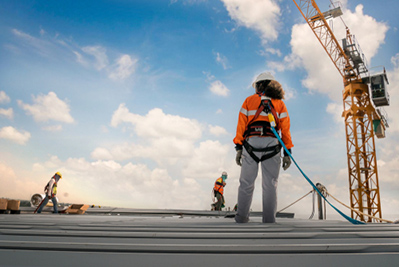Mastering Safe Construction on the Campus Jobsite
The construction industry is bringing real-time information into centuries-old processes. Internet of Things (IoT) devices and sensors can collect job-site data in affordable, efficient, and effective ways, improving efficiency and safety.
Construction among higher education institutions surged in the 1960s to keep pace with baby boomers entering college. Today, these aging buildings require extensive repair and are either being torn down or modernized to attract new student populations and better compete amidst the challenge of lagging enrollments. This, coupled with individual endowments to build new research centers, libraries, and other campus buildings, is making construction projects a common site on campus.
Often with campus construction projects, timing is of the essence so that building projects can be completed as quickly as possible to minimize disruption to learning and student life. Yet, with many students, faculty, and administrators coming and going across campus, how can contractors help move projects along as efficiently as possible, while making safety a priority?

Forward-thinking firms are turning to strategic best practices along with technology to address these issues, including the following:
- Ensure constant communication—Every campus construction project should have a dedicated project manager or administrator who stays in constant contact with the school’s facilities manager, dean, or president throughout the project so that any concerns or issues raised can be immediately addressed.
- Clearly outline the perimeters of the project—Determine the physical boundaries of the jobsite and clearly communicate to all workers the areas that are off-limits and rules of behavior. That should include establishing a zero-tolerance policy, where any inappropriate behavior is reported immediately and investigated. If it is determined that an infraction has occurred, appropriate action should be taken swiftly, including worker dismissal if warranted. Additionally, any reports or concerns related to student safety should be documented in construction daily reports, including information about how the concern was addressed.
- Use technology to gain critical visibility—Internet-of-Things (IoT)-based wearable technologies are enabling a new level of visibility into the jobsite. They allow construction managers to make sure that only qualified workers are on the jobsite and track where workers are in real time, helping to assuage concerns about student security. In addition, these sensors can help contractors monitor productivity to keep costly projects on time and on budget.
Contractors are seeing the promise of these technologies. A new study released by Dodge Data & Analytics (in partnership with Triax Technologies) found that nearly three-quarters of contractors surveyed believe IoT will help them control occupational risks, and about half expect it to reduce risks to the public, as well as financial risks and those related to property damage and construction defects.
Boosting Site Security and Safety Through IoT
Forward-thinking firms have begun using IoT devices to connect workers and equipment on the jobsite and are seeing the benefits in many areas. For example, when workers are equipped with IoT-based wearable sensors, managers can see in real time the workers who are on the jobsite for every trade (plumbing, electrical, etc.) and where they are located as they move around the jobsite. Further, IoT beacons can be placed in areas that are off limits to workers, such as student residence halls or student centers, enabling project managers to see in real time if a worker is near one of these places of interest.
When combined with access-control technologies, these wearable IoT devices can serve as the only credential workers need on site. They can ensure compliance with regulations by granting entry through a turnstile only to workers with up-to-date training and certifications as well as authorization to be on site.
Keeping Workers Safe
Contractors can further promote safety by placing IoT sensors on equipment, such as forklifts, that can communicate with workers’ devices to help ensure awareness that only those who have the proper credentials are using them.
In the event that a safety incident does occur, wearable sensors can alert safety personnel to free falls in real time so they can get help to the scene faster and potentially reduce or limit the severity of injuries. Workers also have the ability to utilize push buttons on these devices to send immediate notifications to supervisors of injuries or unsafe working conditions, enabling workers to contribute to the site-safety culture.
Managing the Moving Parts on the Jobsite
IoT technology is solving a critical need to help contractors keep track of, and effectively manage, the many moving parts on a jobsite—people, equipment, tools, and more.
Because wearables and IoT sensors can monitor where these resources are in real time, they can also help contractors improve productivity. For example, by putting sensors on equipment and tools, contractors can reduce the time wasted in tracking them down. This is a sorely needed capability considering that an average construction worker spends about 20 percent of his/her time waiting for materials, equipment or information, according to a study by the Department of Construction Science and Management at Clemson University.
A key goal of university construction projects is to boost infrastructure to provide modern environments for higher learning that can appeal to a dwindling student population, as well as help them compete for esteemed professors and teaching staff. The challenge for contractors is to help universities meet these goals while minimizing disruption to the campus and keeping the safety of students, faculty, and workers top of mind. Thanks to advanced technologies, such as IoT, they are making the grade when it comes to meeting these challenges.
About the Author
Ian Ouellette is vice president of Product at Triax Technologies, a leading provider of technology for the connected jobsite. He can be reached on LinkedIn or via email at [email protected].